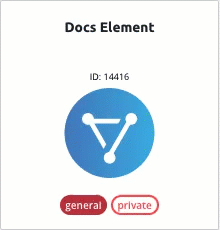Insightly
Authenticate with Insightly
You can authenticate with Insightly to create your own instance of the Insightly element through the UI or through APIs. Once authenticated, you can use the element instance to access the different functionality offered by the Insightly platform.
Authenticate Through the UI
Use the UI to authenticate with Insightly and create an element instance. You will need your User Name or Email Address and API key that you identified in API Provider Setup.
If you are configuring events, see the Events section.
To authenticate an element instance:
- Sign in to Cloud Elements, and then search for Insightly in our Elements Catalog.

- Hover over the element card, and then click Authenticate.

- Enter a name for the element instance.
- Enter your User Name or Email Address and API key that you identified in API Provider Setup.
- Optionally type or select one or more Element Instance Tags to add to the authenticated element instance.
- Click Create Instance.
After successfully authenticating, we give you several options for next steps. Make requests using the API docs associated with the instance, map the instance to a virtual data resource, or use it in a formula template.
Authenticate Through API
Authenticating through API is similar to authenticating via the UI. Instead of clicking and typing through a series of buttons, text boxes, and menus, you will instead send a request to our /instances endpoint. The end result is the same, though: an authenticated element instance with a token and id.
To help you authenticate using our APIs, try the Run in Postman button below. After you import the collection, take a look at the docs.
To authenticate an element instance:
Construct a JSON body as shown below (see Parameters):
{ "element": { "key": "insightly" }, "configuration": { "username": "<Insightly User Name or Email Address>", "password": "<Insightly API key>" }, "tags": [ "<Add_Your_Tag>" ], "name": "<INSTANCE_NAME>" }Call the following, including the JSON body you constructed in the previous step:
POST /instancesNote: Make sure that you include the User and Organization keys in the header. See the Overview for details.Locate the
tokenandidin the response and save them for all future requests using the element instance.
Example cURL
curl -X POST \
https://api.cloud-elements.com/elements/api-v2/instances \
-H 'authorization: User <USER_SECRET>, Organization <ORGANIZATION_SECRET>' \
-H 'content-type: application/json' \
-d '{
"element": {
"key": "insightly"
},
"configuration": {
"username": "xxxxxxxxxxxxxxxxxx",
"password": "xxxxxxxxxxxxxxxxxxxxxxxx"
},
"tags": [
"Docs"
],
"name": "API Instance"
}'
Parameters
API parameters not shown in Cloud Elements are in code formatting.
| Parameter | Description | Data Type |
|---|---|---|
key |
The element key. insightly |
string |
Namename |
The name of the element instance created during authentication. | string |
Usernameusername |
The Insightly User Name or Email Address that you noted in API Provider Setup. | string |
Passwordpassword |
The Insightly API key that you noted in API Provider Setup. | string |
| tags | Optional. User-defined tags to further identify the instance. | string |
Example Response for an Authenticated Element Instance
In this example, the instance ID is 12345 and the instance token starts with "ABC/D...". The actual values returned to you will be unique: make sure you save them for future requests to this new instance.
{
"id": 12345,
"name": "API Instance",
"createdDate": "2018-04-04T20:44:36Z",
"token": "ABC/Dxxxxxxxxxxxxxxxxxxxxxxxxxxxxxxxxxxxxxx=",
"element": {
"id": 5993,
"name": "Insightly",
"key": "insightly",
"description": "Add an Insightly instance to connect your existing Insightly account to the CRM hub, allowing you to manage contacts, accounts, leads, activities and users across multiple Elements. You will need your Insightly account information to add an instance.",
"image": "elements/provider_insightly.png",
"active": true,
"deleted": false,
"typeOauth": false,
"trialAccount": false,
"resources": [ ],
"transformationsEnabled": true,
"bulkDownloadEnabled": true,
"bulkUploadEnabled": true,
"cloneable": true,
"extendable": true,
"beta": false,
"authentication": {
"type": "basic"
},
"extended": false,
"hub": "crm",
"protocolType": "http",
"parameters": [ ]
},
"elementId": 5993,
"tags": [
"Docs"
],
"provisionInteractions": [],
"valid": true,
"disabled": false,
"maxCacheSize": 0,
"cacheTimeToLive": 0,
"configuration": { },
"eventsEnabled": false,
"traceLoggingEnabled": false,
"cachingEnabled": false,
"externalAuthentication": "none",
"user": {
"id": 123456,
"emailAddress": "claude.elements@cloud-elements.com",
"firstName": "Claude",
"lastName": "Elements"
}
}